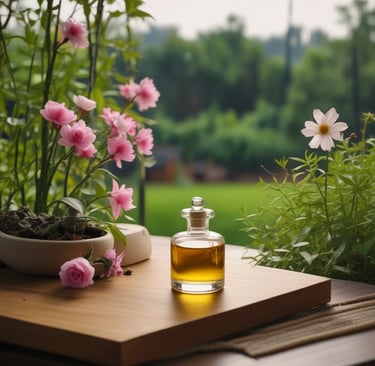How to Choose a Signature Scent That Fits YOU
Blog post description.
6/25/20253 min read


A great perfume should feel like part of you — not just something you wear. Choosing a signature scent isn’t about trends or popular bottles. It’s about finding a fragrance that speaks your style, your energy, your story.
What Is a Signature Scent?
Your signature scent is the one people associate with you. It’s personal, emotional, and often timeless. When you find it, you don’t need a shelf full of bottles — just the right one.
Scent Families: The Basics
Understanding fragrance families helps you navigate what matches you best:
Floral: romantic, soft, classic (rose, jasmine, neroli)
Woody: grounded, elegant, confident (cedar, sandalwood)
Oriental: warm, exotic, sensual (amber, spices, resins)
Fresh: clean, energetic, bright (citrus, mint, green tea)
Gourmand: sweet, cozy, indulgent (vanilla, coffee, tonka)
Match Scent to Personality
Think about your vibe:
Are you bold and creative? Try amber, leather, or oud.
Calm and introspective? You may prefer lavender, sandalwood, or green tea.
Romantic or dreamy? Floral notes like rose or white flowers may suit you.
Skin Chemistry Affects Everything
Perfume can smell different on every skin. Always test it on your wrist, not just paper. Give it a few hours to reveal its full personality.
Tips for Finding Yours:
✅ Test during quiet moments — not rushed or overwhelmed
✅ Don’t follow hype; follow your instinct
✅ Ask how it makes you feel, not just how it smells
✅ Re-test your favorite after a day — do you still love it?
Conclusion: Finding a signature scent is a journey — and it should feel good. At Çakır, we believe every scent should tell a story. Maybe yours is romantic. Maybe bold. Maybe something no one’s bottled before.
Your scent is your voice — wear it your way.
3. Natural vs Synthetic Ingredients: What Every Buyer Should Know
There’s a lot of talk around natural vs synthetic in perfumery — and a lot of confusion too. Is natural better? Are synthetics harmful? Let’s clear the air with real facts.
Natural Oils: The Charm & the Challenge
Natural ingredients like rose, oud, vanilla, and patchouli offer deep, complex scents. They’re extracted directly from plants, flowers, and resins. But:
They can vary by harvest, making every batch slightly different.
They’re often less stable over time.
They are more expensive and sometimes limited in supply.
Synthetic Notes: The Science of Stability
Synthetic molecules are lab-created and often used to mimic or extend natural scents — or create entirely new ones. Common examples:
Ambroxan (ambery musk)
Iso E Super (soft woody)
Calone (marine/fresh note)
Pros:
Consistent from batch to batch
Often longer-lasting and better performing
Expand what perfumers can create
Myth-busting: Not all synthetics are harmful. In fact, many are safer and more allergen-free than naturals.
Why Most Perfumes Use Both
Blending natural and synthetic is the industry standard — and the smart way. This combo allows:
Rich, expressive scent from naturals
Longevity, projection, and stability from synthetics
Even luxury niche brands do this — including Çakır. Why? Because the goal isn’t “natural” or “synthetic.” The goal is beautiful, balanced, honest scent.
Conclusion: Don’t let labels confuse you. Look for quality and creativity, not just what’s natural or lab-made. Great perfumery is about emotion, experience — and balance.
4. Seasonal Fragrances: Choosing the Right Scent for Every Season
Like clothes, perfume fits better when matched to the weather. Heat, humidity, and cold all change how a scent behaves. Here’s how to make your fragrance feel right year-round.
Why Seasons Matter
Perfume doesn’t “smell the same” in all conditions. Heat makes it evaporate faster. Cold can hide soft notes. Matching your scent to the season brings it to life.
What to Wear and When:
🌸 Spring: Fresh florals, light greens, soft citrus
Notes to try: neroli, peony, lilac, bergamot
Vibe: Renewal, elegance, freshness
☀️ Summer: Citrus, aquatic, tropical
Notes to try: lemon, mint, coconut, marine accords
Vibe: Energetic, light, outdoorsy
🍂 Autumn: Amber, spices, woods
Notes to try: cinnamon, cardamom, sandalwood, fig
Vibe: Cozy, warm, grounded
❄️ Winter: Oud, vanilla, resins, musks
Notes to try: frankincense, patchouli, tonka bean, oud
Vibe: Deep, bold, luxurious
Tips:
✅ Store perfumes properly between seasons
✅ Let your body heat “carry” heavier notes in cold months
✅ Use lighter sprays in summer, more concentrated ones in winter
Conclusion: Perfume lives and breathes with the seasons. Matching your scent to the time of year makes it more alive — more you. At Çakır, we design with all seasons in mind, so your scent adapts with grace.
Fragrances
Artisan Parfume Maker
Cakglo Ltd
hi@cakglo.com
Whatsapp Only
+49 1523 8965492
Call Only
+62 822 6165 3220 (Indonesia)
© 2025. All rights reserved.
Cakglo Ltd, Headquarters
London UK
Bandung - Indonesia - Workshop
Istanbul - Turkiye - Branch
CakirParfume – a signature brand of Cakglo Ltd., specializing in artisan fragrances.
